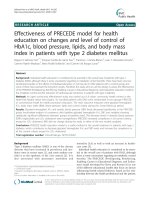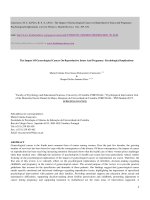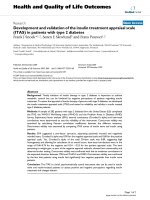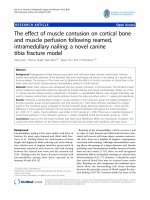The assessment of public knowledge on diabetes mellitus and patient reported outcomes measurement among patients with type 2 diabetes in thailand
Bạn đang xem bản rút gọn của tài liệu. Xem và tải ngay bản đầy đủ của tài liệu tại đây (1.45 MB, 194 trang )
THE ASSESSMENT OF PUBLIC KNOWLEDGE ON
DIABETES MELLITUS AND PATIENT REPORTED
OUTCOMES MEASUREMENT AMONG PATIENTS
WITH TYPE 2 DIABETES IN THAILAND
TIPAPORN PONGMESA
(B.Pharm. (Hons.), Silpakorn University, Thailand)
A THESIS SUBMITTED
FOR THE DEGREE OF DOCTOR OF PHILOSOPHY
DEPARTMENT OF PHARMACY
NATIONAL UNIVERSITY OF SINGAPORE
2010
i
ACKNOWLEDGEMENTS
This thesis would never have been accomplished without the involvement and
support from many people. I would like to take opportunity to express my deep and
sincere gratitude to the following people. My utmost gratitude goes to Prof. Li Shu
Chuen, one of my thesis supervisors, for his brilliant mentorship and supervision, as
well as his kindness, understanding and continuous encouragements since the
beginning of my postgraduate life. Even after he left Singapore for Australia, he has
always tried his best to pay attention to not only my studies but also non-studies
related matters, especially my health. I feel very fortunate to have him as my
supervisor. Likewise, I am immensely grateful to my main supervisor, Asst. Prof.
Wee Hwee Lin, for her generosity in providing me her precious time, knowledge and
invaluable advice during the past few years. She has put hard efforts not only in
making my studies go smoothly, but also in pushing me to be an independent thinker,
careful researcher as well as a good scientific writer.
I wish to convey my special thanks to Ms. Pranee Luckanajantachote, Ms.
Saifon Chaodeekornpun and their diabetes care team at Samut Sakhon Hospital in
Thailand. Without their excellent collaboration and active support, the studies
conducted there would not have been successfully completed.
I am very grateful to the Royal Thai Government for the award of the Thai
MOE-NUS PhD Scholarship; my employer, the Faculty of Pharmacy at Silpakorn
University, for granting me a leave of absence for pursuing a PhD degree; and the
Thai Ambassador to Singapore, His Excellency Nopadol Gunavibool and the staff at
ii
the Royal Thai Embassy in Singapore for their effort and assistance in looking after
the well-being of all Thai students in Singapore.
My sincere gratitude goes to the Department of Pharmacy at NUS for
providing me an opportunity to experience postgraduate study; A/Prof. Chan Sui
Yung for her kindness and constant support; and my PhD thesis committees, A/Prof.
Paul Ho and Asst. Prof. Joyce Lee, for their invaluable advice and generous
contribution. Thanks are also due to all staffs at the department for their kind
assistance in administrative issues.
The journey of my postgraduate study in Singapore would be tougher and
boring without having lovely and helpful seniors and friends around. I would like to
thank my seniors, Sharon and Jin Jing, for providing me guidance and help. I also do
cherish all my colleagues in S7 02-09, Yingjiao, Mandy, Hua Pey, Regine and Wei
Ting, and my unit mates, Sureerat, Nichanan and Poonna, for their kind support and
words of encouragement, as well as the wonderful and joyful moments we have spent
together.
This thesis is dedicated to my parents and family members as well as my
boyfriend for their unflagging love, consistent care and understanding. Without their
great encouragement and support throughout my studies, there is no doubt this thesis
would not have been possible.
iii
TABLE OF CONTENTS
Acknowledgements………………………………………………………………….i
Table of Contents…………………………………………………………………iii
Summary………………………………………………………………………….vii
List of Tables………………………………………………………………………ix
List of Figures………………………………………………………………………xi
List of Abbreviations………………………………………………………………xii
Chapter 1. Introduction……………………………………………………………1
1.1 The global burden of type 2 diabetes mellitus (T2DM)………………………2
1.2 The role of disease management in containing the T2DM epidemic ………4
1.3 T2DM management in Thailand: the state of affairs………………………….5
1.4 Prevention: the cornerstone of T2DM management………………………….6
1.4.1 Knowledge of DM and its role in T2DM prevention…………………6
1.4.2 Factors associated with knowledge of DM …………………………7
1.5 Measuring the outcomes of T2DM management: the role of patient-reported
outcomes (PROs)……………………………………………………………9
1.5.1 QoL as an outcome measure of T2DM management ……………… 9
1.5.2 Treatment satisfaction as an outcome measure of T2DM
management…………………………………………………………… …12
1.5.3 Improving the external validity of PROs instruments: the role of
cross-cultural adaptation………………………………………………… 14
1.6 Research objectives and thesis organization………………………………17
iv
Chapter 2. A Survey of Knowledge on Diabetes in the Central Region of
Thailand………………………………………………………………………….…20
2.1 Introduction ………………………………………………………………21
2.2 Methods……………………………………………………………………23
2.3 Results……………………………………………………………………….28
2.4 Discussion…………………………………………………………………40
2.5 Conclusions…………………………………………………………………46
2.6 Acknowledgements…………………………………………………………46
Chapter 3. A Comparison of Diabetes Knowledge among Residents in Bangkok
and Other Central Provinces of Thailand……………………………………… 47
3.1 Introduction ………………………………………………………………48
3.2 Methods……………………………………………………………………50
3.3 Results………………………………………………………………………51
3.4 Discussion…………………………………………………………………57
3.5 Conclusions…………………………………………………………………61
Chapter 4. Development of a Thai Version of the Audit of Diabetes-Dependent
Quality of Life (ADDQoL-19) Questionnaire: Linguistic and Psychometric
Evaluation…………………………………………………………………………62
4.1 Introduction ………………………………………………………………63
4.2 Methods……………………………………………………………………65
4.3 Results……………………………………………………………………72
4.4 Discussion…………………………………………………………………89
4.5 Conclusions…………………………………………………………………93
4.6 Acknowledgements…………………………………………………………94
v
Chapter 5. Psychometric Evaluation of a Thai Version of the Diabetes
Treatment Satisfaction Questionnaire Status Version (DTSQs)………… … 95
5.1 Introduction ………………………………………………………………96
5.2 Methods……………………………………………………………………97
5.3 Results……………………………………………………………………101
5.4 Discussion…………………………………………………………………107
5.5 Conclusions………………………………………………………………110
5.6 Acknowledgements………………………………………………………111
Chapter 6. Health Status, Quality of Life and Treatment Satisfaction among
Patients with Diabetes in Thailand………………………………………………112
6.1 Introduction ………………………………………………………………113
6.2 Methods……………………………………………………………………115
6.3 Results……………………………………………………………………118
6.4 Discussion……………………………………………………………… 129
6.5 Conclusions……………………………………………………………….132
6.6 Acknowledgements………………………………………………………132
Chapter 7. Association between Polypharmacy and Quality of Life in Patients
with Type 2 Diabetes in Thailand………………………………………………134
7.1 Introduction……………………………………………………………….135
7.2 Methods……………………………………………………………………137
7.3 Results……………………………………………………………………139
7.4 Discussion…………………………………………………………………148
7.5 Conclusions………………………………………………………………150
7.6 Acknowledgements………………………………………………………151
vi
Chapter 8. Conclusions and Recommendations for Future Studies…………152
8.1 Contributions to new knowledge…………………………………………153
8.1.1 Public knowledge of DM in Thailand……………………………153
8.1.2 The measurement of health status, QoL and treatment satisfaction
among patients with DM in Thailand……………………………………154
8.1.3 Polypharmacy in patients with T2DM in Thailand………………158
8.2 Main limitations……………………………………………………………159
8.3 Recommendations for future studies………………………………………159
Bibliography …………………………………………………………………….162
vii
SUMMARY
The prevalence of type 2 diabetes mellitus (T2DM) is rising at an alarming
rate, making DM a major health problem worldwide. A multifaceted approach is
taken in the battle against T2DM, with prevention being an important cornerstone.
Other important components of T2DM management include DM education and
measurement of patient-reported outcomes (PROs). However, currently, the impact of
these approaches among Asian populations is relatively unexplored. The evaluation of
their impact on T2DM management is of particular importance in view of the much
less abundant availability of healthcare resources in Asia.
Based on the afore-mentioned reasons, this thesis therefore focused on various
approaches, especially health outcomes assessment, in T2DM management in Asia. In
our studies, Thailand was chosen as an illustrating example based on the following
considerations. First, T2DM is one of the most prevalent chronic diseases there, and
Thailand is among the top ten countries in Asia with the highest number of adults
with T2DM. Second, there are limited numbers of published studies concerning this
topic in the Thai population. Third, Thailand is a country with a mix of rural and
cosmopolitan areas which may allow further generalization of the results to other
countries with similar socioeconomic compositions.
This thesis is broadly organized into two sections. We started by evaluating
DM knowledge among the general population in central Thailand and found this to be
generally fair indicating the existence of a foundation for further improvement.
Interestingly, we found that the residents in other provinces outperformed those in the
viii
capital demonstrating that easier access to health information may not translate into
better health knowledge. Further, we identified differing factors associated with DM
knowledge between the two groups highlighting the need for different emphasis in
future health promotion and education.
This was followed by our cross-culturally adapting and validating a Thai
version of the Audit of Diabetes-Dependent Quality of life (ADDQoL-19), a DM-
specific QoL instrument, among DM patients in Thailand and found it to be a
promising tool. We also evaluated the psychometric properties of a Thai version of
the Diabetes Treatment Satisfaction Questionnaire status version (DTSQs), a DM-
specific treatment satisfaction instrument, and the results suggested that further
improvements may be required for this instrument to be used in routine clinical
setting. Further, we assessed health status, quality of life (QoL) and treatment
satisfaction of DM patients in Thailand. We found that DM had little effect on the
patients‟ perceived health status but major negative impact on their QoL while their
treatment satisfaction was high. We also found that the factors associated with these
PROs were not identical. In addition, we evaluated the association between
polypharmacy and QoL and found no significant association. Overall, these results
would provide some insights to healthcare providers in designing more holistic
intervention strategies for DM management.
In conclusion, our studies would at least fill a knowledge gap in DM
management in Thailand (if not beyond) and would serve as a foundation for further
studies in more cost-effective approach in managing DM.
ix
LIST OF TABLES
Table 2.1 Characteristics of respondents 29
Table 2.2 The respondents‟ scores in each section of the questionnaire 31
Table 2.3 The respondents‟ scores in each item 33
Table 2.4 The list of other risk factors of DM as mentioned by the respondents 36
Table 2.5 The list of other treatments for DM as mentioned by the respondents 36
Table 2.6 Evaluation of potential factors associated with knowledge on DM of the
respondents ……………………………………………………………39
Table 2.7 Multiple linear regression analysis of factors assiciated with knowledge
of DM 40
Table 3.1 Sociodemographic characteristics of the respondents in the Bangkok and
the other central provinces groups 52
Table 3.2 Overall DM knowledge scores and scores in each section of the
respondents in each group 53
Table 3.3 Factors associated with DM knowledge of the respondents in each group
in univariate analyses 55
Table 3.4 Multiple linear regression analyses of factors associated with knowledge
of DM (separate analyses for residents of Bangkok only, residents of
other provinces only and combined sample) 56
Table 3.5 Major sources of DM information of the two groups 57
Table 4.1 Characteristics of interviewees in cognitive debriefing interviews 74
Table 4.2 Characteristics of respondents in psychometric evaluation 78
Table 4.3 Distribution of responses to the Thai ADDQoL-19 80
Table 4.4 Item rankings before and after weighting by importance………………81
Table 4.5 Standardized factor loadings from confirmatory factor analysis of the
Thai ADDQoL-19 83
Table 4.6 Unforced principal components analysis with varimax rotation and forced
one-factor analysis with N/A items recoded as zeros 85
Table 4.7 Reliability of the Thai ADDQoL-19 with N/A items recoded as zeros 86
x
Table 4.8 Spearman‟s rank correlation among ADDQoL present QoL, DM-
dependent QoL, AWI, EQ-5D utility and EQ-VAS scores…………… 87
Table 4.9 Comparison of the ADDQoL present QoL and AWI scores by gender,
age, duration of known DM, presence of comorbidities/complications
and type of DM therapy……………………………………………… 88
Table 5.1 Characteristics of participants 102
Table 5.2 Scores of each item in the Thai DTSQs 104
Table 5.3 Confirmatory factor analysis of the Thai DTSQs (showing standardized
factor loadings and R
2
for each item) ……………… 105
Table 5.4 Unforced principal components analysis with varimax rotation and forced
one-factor analysis of the Thai DTSQs 106
Table 5.5 Internal consistency reliability of the Thai DTSQs……………………107
Table 6.1 Characteristics of participants 119
Table 6.2 Health status, QoL and treatment satisfaction as reported by the
participants……………. 120
Table 6.3 EQ-VAS score, EQ-5D utility score, AWI score (from the ADDQoL-19)
and Treatment Satisfaction scale total (from the DTSQs) according to
patient characteristics in univariate analyses……. 124
Table 6.4 Associations between patient characteristics and EQ-VAS score, EQ-5D
utility score, AWI score (from the ADDQoL-19) and Treatment
Satisfaction scale total (from the DTSQs) in multiple linear regression
analyses 127
Table 6.5 Impact of DM on the QoL domains in the Thai ADDQoL-19……… 128
Table 6.6 Satisfaction with each aspect of DM treatment of the participants as
measured by the Thai DTSQs 129
Table 7.1 Numbers of medications used according to participant characteristics 140
Table 7.2 Patterns of DM regimens of the participants 144
Table 7.3 Treatment of hypertension and dyslipidemia 146
Table 7.4 Ten most commonly used medications among the participants……….147
Table 7.5 Patterns of medication use and QoL scores 148
xi
LIST OF FIGURES
Figure 2.1 Distribution of the respondents' overall DM knowledge score…… 30
Figure 2.2 Major sources of DM information of the respondents…………… 37
Figure 5.1 Distribution of the participants‟ Treatment Satisfaction scale total 103
Figure 6.1 The participants' reported health status by dimension as measured by the
Thai EQ-5D 121
xii
LIST OF ABBREVIATIONS
ACEI
-
Angiotensin-converting enzyme inhibitors
ADA
-
American Diabetes Association
ADDQOL
-
Audit of Diabetes-Dependent Quality of Life
ADR
-
Adverse drug reaction
ANOVA
-
Analysis of variance
ARB
-
Angiotensin II receptor blocker
AWI
-
Average weighted impact
BB
-
Beta-blocker
BMI
-
Body mass index
CCB
-
Calcium channel blocker
CFA
-
Confirmatory factor analysis
CFI
-
Comparative Fit Index
CI
-
Confidence interval
CVD
-
Cardiovascular disease
DM
-
Diabetes mellitus
DRP
-
Drug-related problem
DTSQc
-
Diabetes Treatment Satisfaction Questionnaire change version
DTSQs
-
Diabetes Treatment Satisfaction Questionnaire status version
EFA
-
Exploratory factor analysis
EQ-5D
-
EuroQol-5 Dimensions
FPG
-
Fasting plasma glucose
HbA1c
-
Glycated hemoglobin
xiii
IDF
-
International Diabetes Federation
IFG
-
Impaired fasting glucose
IQR
-
Interquartile range
ISPOR
-
International Society for Pharmacoeconomics and Outcomes
Research
ML
-
Maximum likelihood
MLR
-
Multiple linear regression
N/A
-
Not applicable
NHSO
-
National Health Security Office, Thailand
OHA
-
Oral hypoglycemic agent
OR
-
Odds ratio
PCA
-
Principal components analysis
PRO
-
Patient-report outcome
QoL
-
Quality of life
RMSEA
-
Root Mean Square Error of Approximation
R
2
-
Standardized factor loading squared
SD
-
Standard deviation
SE
-
Standard error
SEM
-
Structural equation modeling
SPSS
-
Statistical Package for the Social Sciences
T1DM
-
Type 1 diabetes mellitus
T2DM
-
Type 2 diabetes mellitus
THB
-
Thai Baht
TLI
-
Tucker Lewis Index
TTO
-
Time trade-off
xiv
USD
-
United States Dollar
VAS
-
Visual analogue scale
WHO
-
World Health Organization
WI
-
Weighted impact
Chapter 1. Introduction Pongmesa, Tipaporn
1
CHAPTER 1
Introduction
Chapter 1. Introduction Pongmesa, Tipaporn
2
1. INTRODUCTION
1.1. The global burden of type 2 diabetes mellitus (T2DM)
T2DM, accounting for 90 to 95% of all DM cases,
(1, 2)
is characterized by the
presence of insulin resistance or relative insulin deficiency. It often has a familial or
genetic predisposition, and is largely associated with advancing age, sedentary
lifestyle and obesity.
(1-3)
Due to its insidious and slow onset, T2DM is frequently not
diagnosed until symptoms of its complications appear.
T2DM places a tremendous burden on both patients and healthcare systems.
According to the World Health Organization (WHO), DM accounted for
approximately 987,000 deaths or 1.7% of the total world mortality in 2002,
(4)
and its
mortality rate is projected to increase from 1.9% in 2004 to 3.3% in 2030.
(5)
The
International Diabetes Federation (IDF) estimated that the total number of deaths
from DM in the age group between 20 to 79 years would be nearly four millions,
accounting for 6.8% of the global mortality for all age groups in 2010.
(2)
DM was
ranked as the fourth leading cause of death by disease worldwide and in Thailand in
2005.
(6, 7)
However, the real impact of DM is likely to be higher as DM is often under-
reported as the principal cause of death.
(2)
Additionally, T2DM is one of the principal causes of premature morbidity in
most countries.
(2)
Approximately 20-40% of T2DM patients have retinopathy at the
time of diagnosis,
(8)
and 2% could become blind after having T2DM for fifteen
years.
(9)
Compared with the general population, patients with T2DM have two- to
four-fold increased risk of cardiovascular disease (CVD), which accounts for 75% of
all deaths among T2DM patients.
(10)
Hypertension is also approximately twice as
Chapter 1. Introduction Pongmesa, Tipaporn
3
common in T2DM patients as individuals without DM.
(9, 10)
DM nephropathy occurs
in 15 to 60% of patients with T2DM
(11)
and many patients have to undergo dialysis
and/or kidney transplant eventually.
(9)
Furthermore, T2DM patients have an increased
risk of developing DM neuropathy, which is the most common cause of non-
accidental limb amputation and foot ulceration.
(3)
Besides increasing mortality and morbidity, T2DM could profoundly worsen
quality of life (QoL) of both patients themselves and their caregivers.
(12)
T2DM
patients are prone to experience a variety of psychosocial problems, including guilt,
frustration, anxiety, depression and social withdrawal,
(12-14)
and possibly encounter
restricted range of employment.
(13)
For caregivers, some even have to quit their jobs
and have their lifestyle changed to provide care for the patients, not to mention that
they are also likely to suffer from psychosocial impacts of T2DM as well.
In addition to substantial physical, mental and social well-being burden,
T2DM places heavy economic burden on both the individuals and healthcare
systems.
(1, 15)
Global healthcare expenditure attributable to DM and its complications
is estimated to be at least 376 billion U.S. Dollar (USD), accounting for 12% of total
health expenditure in 2010, and the amount is projected to be over 490 billion USD in
2030.
(2, 5)
Even so, this mentioned expenditure is likely to be an underestimate as
intangible costs such as pain and suffering, reduction in QoL, as well as the costs of
undiagnosed cases of T2DM were excluded.
(16)
Likewise, the economic burden of DM in Asia is also enormous due to its high
incidence and prevalence.
(9)
In Thailand, the healthcare expenditure for DM is
Chapter 1. Introduction Pongmesa, Tipaporn
4
estimated at approximately 510 million USD, accounting for 11% of total health
expenditure in 2010, and is projected to be at least 720 million USD in 2030.
(17)
A
point of concern is that the prevalence of T2DM is increasing in people aged 20 to 64
years, which is considered the economically-productive age group. Therefore,
enormous healthcare expenditure and also the loss of productivity due to T2DM and
its complications will impose a much higher burden on many countries in the
foreseeable future.
(9, 16)
1.2. The role of disease management in containing the T2DM epidemic
Due to the need to improve quality of healthcare as well as the growing
prevalence of chronic diseases which is inevitably accompanied by greatly increased
healthcare expenditures, disease management has been increasingly accepted to
represent a dramatic shift in healthcare delivery philosophy in the new millennium.
Generally speaking, disease management could be defined as “an organized,
proactive, multi-component, patient-centered approach to healthcare delivery that
involves all members of a defined population who have a specific disease entity or a
subpopulation with specific risk factors.”
(18)
Indeed, being a common and costly
chronic disease that is often complex and difficult to manage, T2DM is an ideal
candidate for applying the concept of disease management.
(18)
The main goal of
T2DM management is to optimize the patients‟ clinical, humanistic and economic
outcomes while reducing the overall healthcare costs.
(19, 20)
However, for an effective
T2DM management program, patients themselves as well as other stakeholders (i.e.
healthcare practitioners/providers, policy makers, payers, purchasers and product
producers) have to be involved in the care process.
(19, 21)
Chapter 1. Introduction Pongmesa, Tipaporn
5
1.3. T2DM management in Thailand: the state of affairs
In order to improve the quality and standards of the national healthcare system,
the National Health Security Act was enacted in Thailand in 2002.
(22)
Realizing the
growing burden of T2DM that would have potentially overwhelmed the country‟s
healthcare system, the National Health Security Office (NHSO) places T2DM as one
of the important diseases to focus its attention.
(23)
Since then, many national
campaigns have been launched to deal with this potential growing epidemic. These
campaigns include promoting health screening of general population, especially high-
risk groups, promoting healthy, active lifestyle and providing DM education to both
patients and the public.
(23)
In addition, as there is an obvious and worrying trend of
downward age shift with T2DM being increasingly diagnosed among younger Thais,
resulting from an increasing trend of childhood obesity, campaigns to prevent obesity
among Thai children have also been initiated.
However, according to the country‟s Third National Health Examination
Survey in 2004, T2DM continues to be a major public health problem with the
prevalence rates of DM and impaired fasting glucose (IFG) in Thai adults aged >15
years stood at 6.7% and 12.5%, respectively.
(24)
Furthermore, the survey revealed that
more than half of those identified with T2DM had not been previously diagnosed. The
diagnosis and appropriate management level of DM comorbidities such as
hypertension and dyslipidemia among individuals with DM were also found to be
low.
(24)
These findings indicate that stronger efforts are needed for the prevention and
control of T2DM among Thai populations.
Chapter 1. Introduction Pongmesa, Tipaporn
6
Incidentally, an improvement in medical care for T2DM patients in Thailand
has been gradually made, with the Chronic Care Model, developed by Wagner EH et
al. in the U.S., being applied to T2DM care system in some tertiary hospitals with full
complement of clinical support services.
(25)
However, even though this
implementation would potentially contribute to a more effective management of
T2DM in Thailand, it requires much financial and human resources to move forward;
and this could be a major obstacle for the country. Therefore, management of T2DM
in Thailand is challenging and still requires much more effort in its improvement.
1.4. Prevention: the cornerstone of T2DM management
Accepting that the T2DM epidemic is currently a major health concern
worldwide, prevention and control of T2DM including its complications is logically
one of the priorities for T2DM management.
(2)
Theoretically speaking, disease
prevention for T2DM could be implemented at three levels: (a) primary prevention in
general population, particularly in high risk individuals, to reduce the incidence of
T2DM; (b) secondary prevention in undiagnosed people for an early detection of the
disease and prevention of DM complications; and (c) tertiary prevention in
symptomatic patients to prevent the progression of the disease and development of its
complications. From the perspective of public health, if implemented successfully,
primary prevention is likely to be the most cost-effective method of reducing the
incidence and prevalence of T2DM.
(19, 26)
1.4.1. Knowledge of DM and its role in T2DM prevention
For primary prevention, health education and promotion are important steps
towards T2DM prevention and control, and they are beneficial not only to the patients
Chapter 1. Introduction Pongmesa, Tipaporn
7
but also the general population.
(27-29)
Primary prevention of T2DM by raising public
awareness of the disease should be considered as a priority due to the insidious and
slow onset of T2DM. Many people are unaware that they have developed the disease
until symptoms of its complications appear. Adequate knowledge of T2DM
symptoms is therefore important for ensuring early diagnosis and prompt treatment to
reduce the risk of developing major DM complications.
(30)
Furthermore, if the public
is well aware of the detrimental impact of T2DM and the fact that T2DM is largely
associated with sedentary lifestyle and obesity, they are possibly keener to adopt a
healthy lifestyle to delay or reduce the risk of developing this devastating disease.
Finally, with adequate knowledge on T2DM management and monitoring, healthy
populations can play an important role in guiding their relatives who have T2DM to
comply with the required treatment and self-monitoring. As highlighted by Gunay et
al.,
raising public awareness of DM would contribute to reduced incidence and
prevalence of the disease as well as improved overall health behavior of the
society.
(31)
However, as culture and tradition can influence the formation of
perception and knowledge among populations, the level of knowledge on DM among
different populations is likely to be different.
(31)
Hence, instead of assuming the
results from published studies to be applicable, it is essential to assess the level of DM
knowledge and ascertain the knowledge gap about DM among the targeted
population. This information would assist healthcare providers/educators in
formulating an effective health education and promotion program in a given country.
1.4.2. Factors associated with knowledge of DM
Similar to the level of DM knowledge, a number of previous studies
conducted in patients with DM and/or a healthy population illustrated that factors
Chapter 1. Introduction Pongmesa, Tipaporn
8
associated with knowledge of DM among populations could vary from country to
country. According to the findings from those studies, knowledge on DM could be
affected by various sociodemographic and clinical variables of the study population.
These variables included gender,
(32-36)
age,
(29, 33, 34, 37-46)
ethnicity,
(32, 34, 41, 42, 44)
education level,
(28, 29, 31-44, 46, 47)
occupation/employment status,
(35, 39, 47)
marital
status,
(36)
having family history of DM or having friends who had DM,
(29, 31, 32, 39, 41, 47)
having DM themselves,
(28, 31, 41, 46)
type of DM (type 1 or type 2),
(29, 32, 35)
duration of
diagnosed DM
(28, 33, 34, 38, 43)
and type of treatment regimen (lifestyle modification,
oral hypoglycemic agents and/or insulin).
(29, 33, 35, 42, 43)
Despite inconsistent results among studies, education level was found to be the
main determinant of DM knowledge in most studies. However, again, there were
conflicting conclusions as to the impact of some factors. For example, while many
studies found a negative relation between age and knowledge of DM,
(29, 33, 34, 37-43)
several studies found lower level of DM knowledge in younger people,
(44-46)
and a
number of recent studies revealed no association between the two variables.
(28, 31, 47)
Likewise, while males were found to have better knowledge of DM in a number of
studies,
(32, 33, 35, 36)
contradicting result was obtained from a study in the U.S.
(34)
Adding further to the confusion, several studies found no association between gender
and knowledge of DM.
(31, 39, 40, 44, 46, 47)
This highlights that this is an area that would
require more research.
Chapter 1. Introduction Pongmesa, Tipaporn
9
1.5. Measuring the outcomes of T2DM management: the role of patient-
reported outcomes (PROs)
1.5.1. QoL as an outcome measure of T2DM management
QoL has become a topic of interest in healthcare research and practice since
the WHO defined health as “a state of complete physical, mental and social well-
being and not merely the absence of disease or infirmity” in 1948.
(48)
While its
universally agreed definition still cannot be achieved, with definitions proposed
ranging from narrow to broad ones, QoL is defined by the WHO as “an individual's
perception of their position in life in the context of the culture and value systems in
which they live and in relation to their goals, expectations, standards and concerns.”
(49)
In PRO research, the term „health-related quality of life (HRQoL)‟ is
frequently utilized interchangeably with the term „QoL‟ to represent parts of QoL that
relate to health or medical perspective.
(48, 50)
HRQoL is defined by the International
Society for Pharmacoeconomics and Outcomes Research (ISPOR) as “a broad
theoretical construct developed to explain and organize measures concerned with the
evaluation of health status, attitudes, values, and perceived levels of satisfaction and
general well-being with respect to either specific health conditions or life as a whole
from the individual‟s perspective.”
(51)
However, there has been growing consensus
that there are clear distinctions between the two terms,
(52)
and in order to obtain a
more comprehensive assessment of the impact of a disease and its treatment on a
patient‟s life, it is necessary to assess QoL.
(52-54)
Even though there are areas of dispute over the dimensions of QoL, most
health care researchers do agree that QoL possesses the following characteristics: (a)
Chapter 1. Introduction Pongmesa, Tipaporn
10
QoL is a subjective evaluation; (b) QoL is a multi-dimensional construct; and (c) QoL
encompasses, at a minimum, three broad domains of health, i.e. physical, mental and
social functioning.
(50, 55, 56)
QoL has been widely recognized as one of the standard
outcomes in the management of T2DM due to several obvious reasons. First, in the
last two decades, healthcare delivery philosophy has shifted from the disease-centric
approach towards the patient-centric approach where the patients‟ perspective is
incorporated into healthcare decision making and chronic disease management.
Therefore, greater emphasis has been placed on assessing the patients‟ QoL as well as
other PROs such as treatment satisfaction.
(12, 18, 48, 57)
Second, as T2DM is still incurable at the moment, therapeutic interventions
can only control the progression of the disease and prolong survival. On top of that,
T2DM patients are required to comply with long-term treatments, some of which
could probably cause significant adverse drug reactions (ADRs), side effects or even
functional impairments that would worsen the patients‟ physical, mental and social
well-being. Hence, QoL is undoubtedly an important outcome in T2DM care in
addition to clinical outcome parameters such as glycated hemoglobin (HbA1c) and
fasting plasma glucose (FPG) that are traditionally regarded as the principal endpoints
of T2DM therapy.
(48, 55, 57)
QoL instruments could be classified in several ways. To be appropriate for this
thesis, we classify them into generic instruments and specific instruments (e.g.
disease-specific, population-specific and function-specific).
(48, 57-59)
Generic
instruments are useful for comparisons across diseases, interventions and population
groups. However, they may be less sensitive to small but clinically important changes









